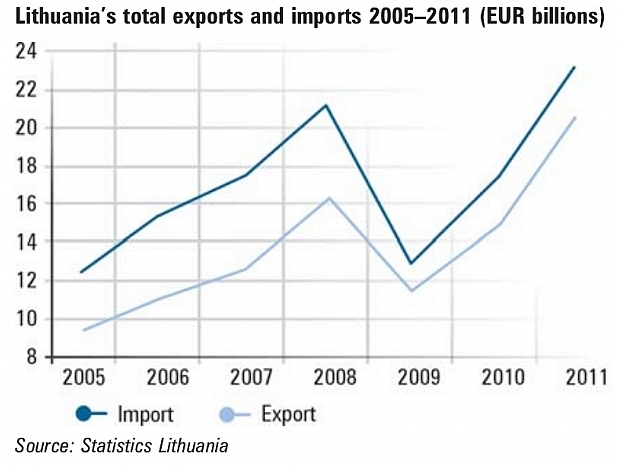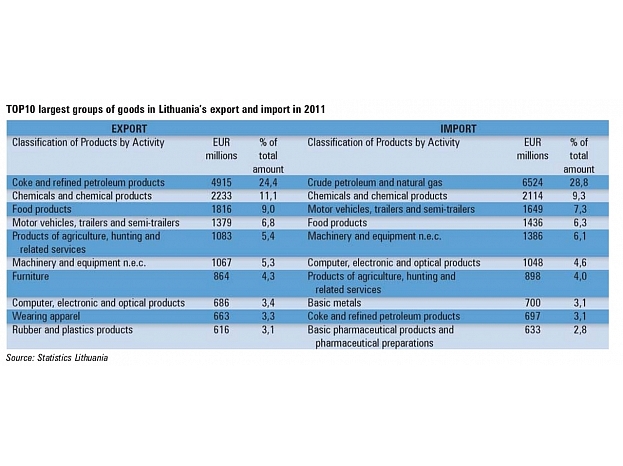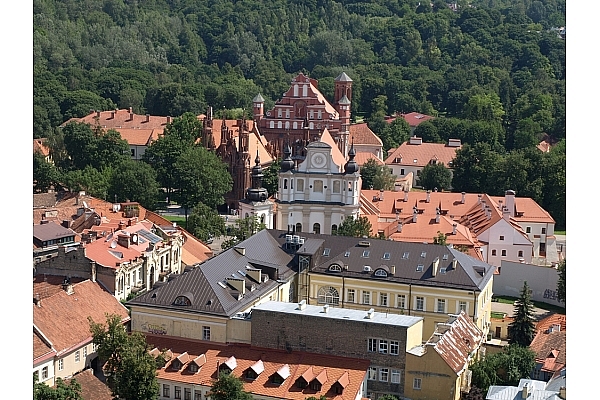External trade of Lithuania
Foreign Trade of Lithuania
The Baltic leader recovers from the crisis
The export of goods from Lithuania as befits the largest Baltic country, significantly exceeds that of its immediate neighbors and, like its neighbors, has show record high rates of growth.
Lithuania’s exports, which, following the global crisis, have been the main driver of the Lithuanian economy, stimulating industrial manufacturing and employment, in 2011 exceeded pre-crisis levels. Exports in 2011 totaled EUR 20,17 billion, which is EUR 4,45 billion more than the year before, while imports of goods totaled EUR 22,64 billion, which is almost EUR 5 billion more than a year ago. Both exports and imports grew by 28% compared to a year earlier.

Autors: lietuvas_areja_tirdznieciba_en_22_1_en_3_804x612
Main trading partners
As in previous years, Lithuania’s main export and import trading partners in total were the nations of the EU, however, counted by individual nations, the highest proportion of both exports and imports was to and from Russia. In 2011, 61% of all good exported from Lithuania were delivered to EU countries and 13,4% to CIS countries. In terms of exports by country, the largest recipients were the closest neighboring countries: 17% of Lithuania’s exports of goods went to Russia, 10% to Latvia, 9% to Germany, while Estonia and Poland took 7% each. The largest oil refinery in the Baltic region is in Mažeikiai, Lithuania, the country also has a well-developed pharmaceutical industry and food industry, and therefore export statistics reflect the strongest branches of Lithuanian industry and its products.
56% of imported goods in Lithuanian in 2011 came from the EU countries – 37% from CIS countries. Russia dominates imports (33% of total 2011 import volume), followed by Germany (10%), Poland (9%) and the neighboring Baltic country of Latvia (7%). A significant part of Lithuania’s imports is comprised of energy (which explains why Russia is among the leading importers), good as well as raw materials (pharmaceuticals, machines and equipment, wood, etc.), which affirm Lithuania’s recovery from the crisis, creating demand for both raw materials and capital goods.

Autors: lietuvas_areja_tirdznieciba_en_22_2_en_2_1213x520
Forecasts
* According to estimates by various analysts, in 2012, exports could grow between 6,8–9,5%, but the volume of imports – by 7,3–9,4%.
* The rapid growth of exports and imports in 2011 is evidence of the Lithuanian economy’s recovery from the crisis. Analysts are still concerned about private consumption, which seems to be on a fragile path of growth. To be sure, the debt burden of Lithuanians is one of the smallest in the EU, therefore it affects consumption comparatively little, in addition, wages are returning to growth, unemployment is shrinking but still at one of the highest levels in the EU. The bankruptcy of the Lithuanian Snoras bank at the end of 2011 had an impact on consumer sentiment.
* In 2012 and beyond, taking into account that one of Lithuania’s most significant trading partners is Russia, there can be both a positive and negative impact from Russia joining the WTO.
* Some concern arises with regard to the effect of EU sanctions on Belarus, which is a significant transit partner.
* The continued growth of Lithuania’s exports depends on an economy recovery in Lithuania’s main trading partner nations – not only in the European Union, but also especially in the neighboring countries and Russia. It is expected that the further recovery of exports will be based on the traditionally strong branches of industry such as the export of wood, plastic, rubber and food products.
* Analysts believe that, in order for Lithuania to further conquer world markets, it is necessary to produce goods with higher value added. Since this will take time, for the time being, Lithuania’s competitive advantage will remain in the production of goods in bulk.
Useful links
Statistics Lithuania – www.stat.gov.lt
The Ministry of Economy of Lithuania – www.ukmin.lt/
Lithuanian Investment Attraction Organisation – www.businesslithuania.com
Photo: Stock.XCHNG





